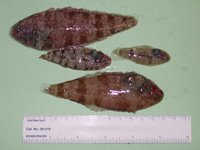Monday, December 18, 2006
Fish dance on sulphur cauldrons (+Video)

From BBC News (UK): Scientists have witnessed the extreme lifestyle of tonguefish that like to skip across pools of molten sulphur (sulfur).
The animals - a type of flatfish** - were filmed on three expeditions to undersea volcanoes in the western Pacific.
Huge numbers were seen to congregate around the sulphur ponds which well up from beneath the seafloor.
Researchers from the University of Victoria, Canada, are trying to work out how the creatures survive in such a hostile environment.
'There are a lot of toxic heavy metals coming out of these active volcanoes,' explained Dr John Dower* (lab), a fisheries oceanographer.
'The water is very warm, and it can be very acidic, the pH can be as low as two like sulphuric acid,' he told BBC News.
'And yet here we've got a group that has not previously been seen in this type of environment and they're doing very well - they're actually thriving.'
The fish have been studied with remotely operated submersibles, including the Jason II*** vehicle this year.
Continued at "Fish dance on sulphur cauldrons" [Extremophiles]
--------
Based on NOAA's 2006 Submarine Ring of Fire expedition (April 18 - May 13, 2006):
The 2006 Submarine Ring of Fire expedition is the third in a series of explorations of the submarine volcanoes lying along the Mariana Arc, extending from south of the island of Guam northward more than 800 nautical miles (1450 km). We discovered some amazing places in 2004, including an erupting volcano (NW Rota-1), liquid CO2 venting (NW Eifuku), the shallowest yet discovered "black smoker" chimneys (East Diamante) and more than 12 new species of chemosynthetic organisms at hydrothermal vent sites.
"A dense group of tonguefish on the sedimented seafloor at Daikoku. The fish are more active than they appear at first glance."
"A dead mid-water fish floated down to the seafloor and is attacked by tonguefish at Daikoku."
-------
*Dr. John Dower's research interests:
"My research focuses on the various ways in which interactions between biology and physics structure pelagic marine ecosystems. I am particularly interested in the effect of physical variability on the ecology of (and interactions between) larval fish and zooplankton, and the ways in which variability in the physical environment regulates recruitment in marine fish populations..."
-------
**Info on Flatfish and Evolution:
Flatfish have been cited as dramatic examples of evolutionary adaptation. For example, Richard Dawkins in The Blind Watchmaker, explains the flatfish's evolutionary history as:
... bony fish as a rule have a marked tendency to be flattened in a vertical direction.... It was natural, therefore, that when the ancestors of [flatfish] took to the sea bottom, they should have lain on one side.... But this raised the problem that one eye was always looking down into the sand and was effectively useless. In evolution this problem was solved by the lower eye 'moving' round to the upper side.
The development of flatfish is thus considered to recapitulate their evolutionary history.
-------
***Info on Jason/Jason II/Medea from the Woods Hole Oceanographic Institution:
...Jason/Medea is a remotely operated vehicle (ROV) system designed by the Institution's Deep Submergence Laboratory for scientific investigation of the deep ocean and seafloor. It is a two-body ROV system, with Medea serving in a tether management role that decouples Jason from surface motion...
Technorati: extremophiles, biology, environment
Add to: CiteUlike | Connotea | Del.icio.us | Digg | Furl | Newsvine | Reddit | Yahoo